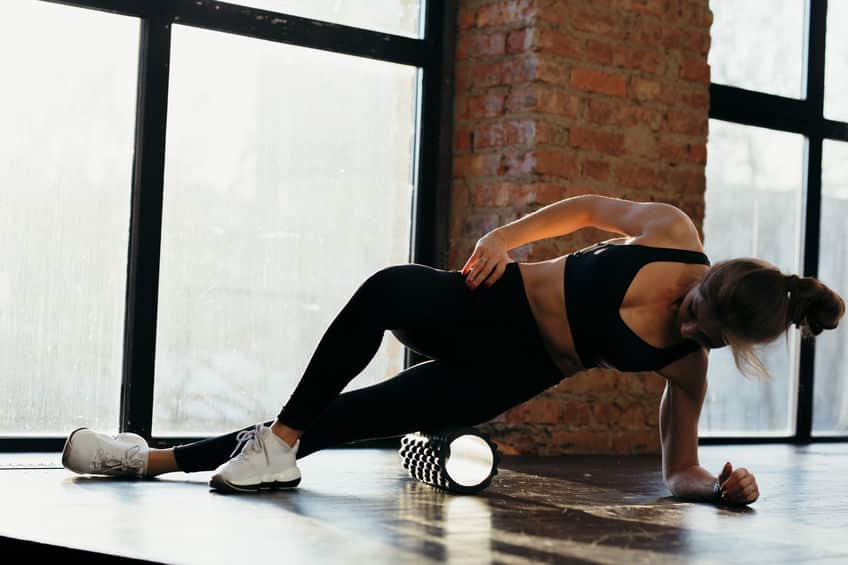By Kathy Driscoll –
Some people just love tossing out phrases like “hurts so good” and “no pain, no gain.” Unfortunately, it’s never quite clear whether the hurt or pain actually delivers more than just discomfort. Certainly, that’s got to come to mind with the increasingly popular practice of foam rolling.
Rolling sounds innocent enough, especially when the word “foam” is added to the mix. But these seemingly ubiquitous rollers can deliver quite a bite on legs, butts, backs and other body parts. But in this case, the roll may be worth the pain—or at least some of the bite.
For the uninitiated, consider this starting position. Elbows in a forearm “plank” position, body being held in place with a three foot plastic roller place under the quads. Once set up, the movement (and pain) begin as the body gently moves over the roller until it reaches the knees and then rolls back up to the hips.
It’s working when the rolling starts hurting, a wonderfully painful signal that might convince some that maybe this practice isn’t worth the ouch factor. Fortunately, relief— and some maintain relaxation—does come for the determined. The rolling process, they claim, pushes the tightness out and softens up the quads.
Such is the pleasure-pain trade off of foam rolling, that “hurts so good” feeling that runners, weight-lifters, gym-goers and weekend warriors have been raving about for years. The practice has actually become big business of sorts, with foam rollers now coming in all sorts of shapes, sizes and textures to help loosen up everything from the legs to the upper back.
Great, but what’s the ultimate payback beyond simply initial pain follow by a gradual relaxation? Proponents claim rolling addresses a host of physical issues.
Pro-athletes and gym-goers, in fact, have raved for years that foam rolling can relieve muscle tightness, soreness and inflammation. They claim is even reduces lower back pain and managing the symptoms of fibromyalgia. Heck, one roller evangelist dubbed the practice “a love letter to your tired muscles.”
What’s the secret? Foam rolling has been linked to fascia training, a kind of physical training focused on the health of the connective tissues in the body, such as ligaments and tendons. The “self-myofascial” release that foam rolling provides can help boost the blood flow to muscles and decrease recovery time after a workout. Combined, they help promote mobility and reduce inflammation. The best part, experts say, is that each practitioner control the pressure they apply.
Some say they find foam rolling before a workout can help prevent injuries while others say the best benefits are after to relax muscles.
Avid runners are particularly drawn to rolling because it’s been shown to increase flexibility and reduce stiffness, according to Runners World. “Using foam rolling as part of an active warmup will be particularly useful for sports that require both flexibility and force production,” the magazine’s reviewers wrote.
Rolling was introduced over 30 years ago by physical therapist Sean Gallagher, who was a student of The Feldenkrais Method. The foam roller was considered a way to reduce muscle pain and improve mobility by raising a person’s awareness of their own body and how it moves. The practice’s wasn’t an overnight success but did start to draw attention when Gallagher began working with Broadway star Jerome Robbins, telling him about the benefits of foam rolling. The feedback from dancers was “overwhelmingly positive,” writes Conor Heffernan in Physical Culture Study, a website devoted to the history of fitness.
Foam rolling gained even more traction in the 1990s when physical therapist Mike Clarke spread the word among the weight-lifting community. He called the treatments “self-myofascial release” and produced manuals and articles extolling the benefits of foam-rolling for self-massage. The popularity of foam rolling increased even more about 15 years ago when physical therapists Eric Cressey and Mike Robertson wrote an article extolling its virtues. That same year, the first foam roller patent was registered in the U.S., jump-starting the rolling craze business.
Rolling can be done at almost any time before, after, or during a workout. Experts, however, stress, that it’s important to roll regularly. Example. At the desk too long? Go on a roll to straighten up bad posture, loosen up stiffness and expunge soreness. Foam rollers have also found a place in physical therapy to improve circulation and restore healthy muscle tissue
Of course, the rolling ouch factor is always present. “Foam rolling can be painful, especially if you’re new to it. Pain in a specific area while foam rolling is typically a sign that your muscle or tissue is tight and needs some TLC,” Nicole Davis, an ACE Certified Trainer, told Healthline.com. Her advice is obvious and profound. Roll in slowly. “Ease into painful spots by starting in the areas right around it and sensitivity should decrease fairly quickly. But if it’s too much to bear, don’t continue.”













